Statue of Abolitionist John Brown (1911)
Introduction
Text-to-speech Audio
John Brown was a central figure in the abolitionist movement of the pre-Civil War era, and this statue of him was erected at this site in 1911 thanks to the donations of hundreds of Kansas City residents, most of whom were members of the Black Community. Brown was chosen by leaders of the AME church and Western University who sought to honor his fight against the institution of slavery. Located on the former campus of Western University, the only historically-Black university in Kansas, the John Brown statue is a monument to Brown's efforts to end slavery by any means necessary. Brown believed that the rhetoric and peaceful tactics traditionally used by abolitionists were too weak, and he led armed resistance to protect the Free State communities of Kansas Territory and elsewhere. Brown led several campaigns during the “Bleeding Kansas” border wars between abolitionists and slavery sympathizers. In 1859, he was hanged for his raid in Harpers Ferry, Virginia, which sought to create a place of refuge and safety for maroon communities who could escape slavery while remaining in the American South instead of joining other communities of free people in Canada.
Images
John Brown Statue, erected in 1911 by Western University
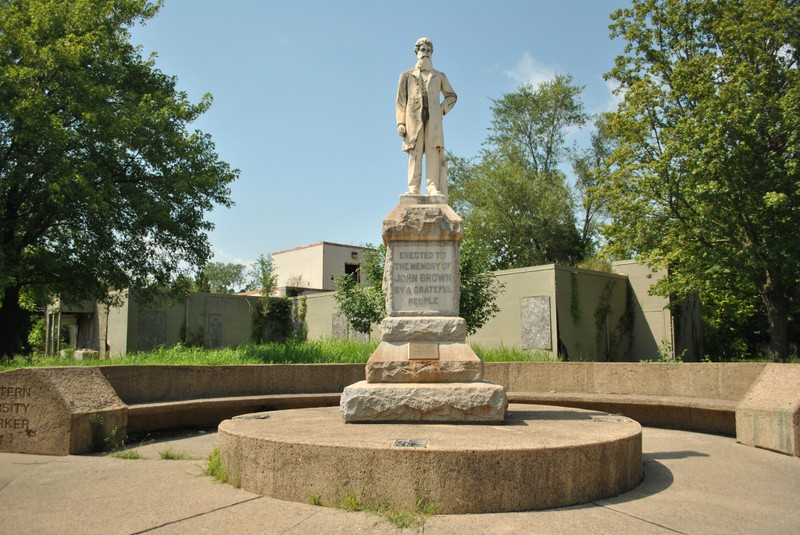
John Brown, around the time he lived in Kansas Territory
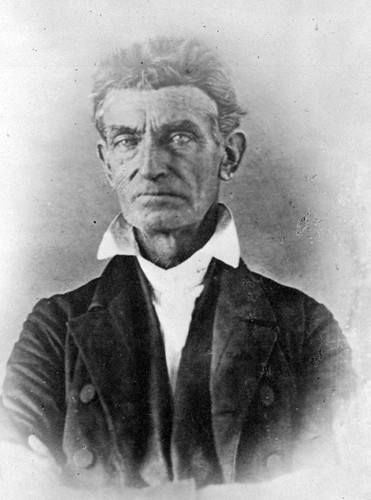
Cabin owned by John Brown's relatives, where he lived when he moved to Kansas Territory and organized his campaigns. The cabin is now located in the John Brown Memorial Park in Osawatomie.
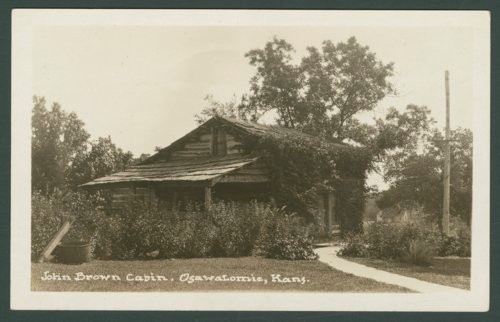
"Tragic Prelude" a painting by artist John Steuart Curry depicting John Brown at the center of the Bleeding Kansas clashes
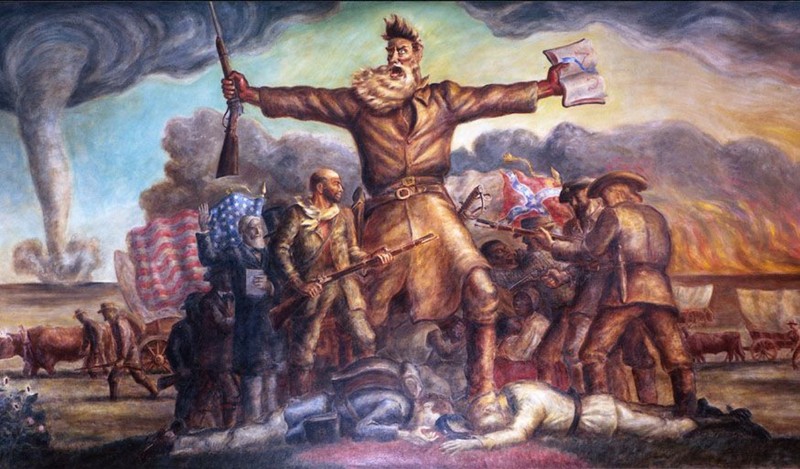
An anti-slavery meeting scheduled for December 2, 1859, the day John Brown would be executed
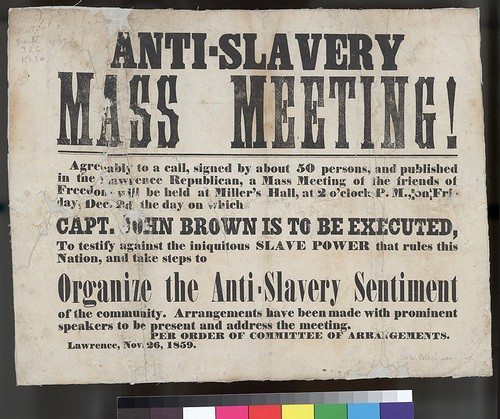
Sketch of John Brown riding on his coffin on the way to his execution
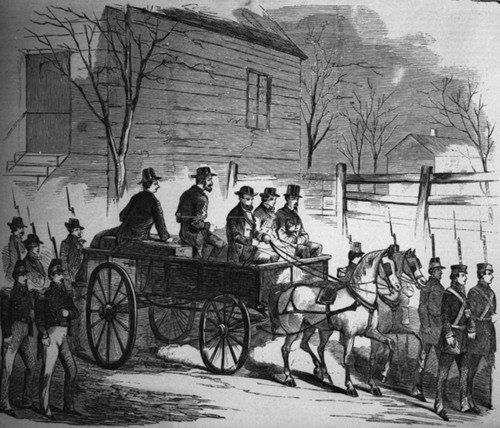
Kansas Tourism
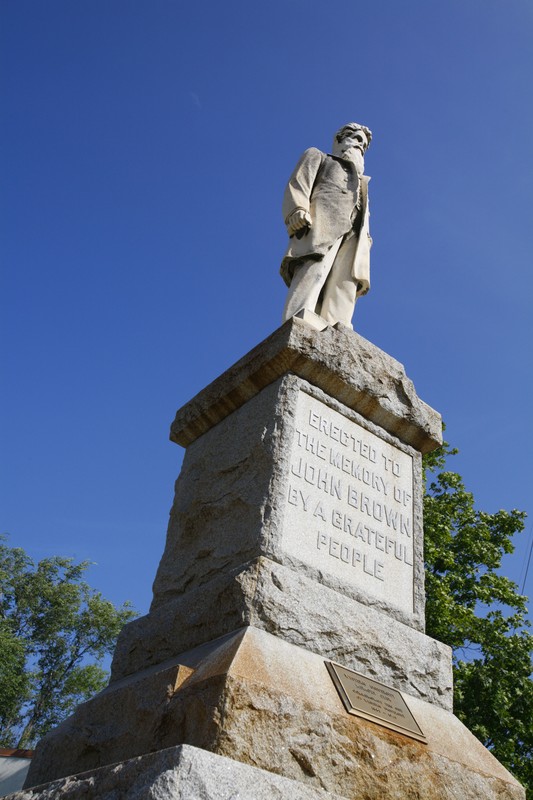
Backstory and Context
Text-to-speech Audio
John Brown is a noted figure in both Kansas and United States history for his role in the abolition movement and the conflict known as Bleeding Kansas. A controversial figure in his time, he is memorialized in Kansas City, Kansas, at the former site of Western University, a historically Black college that closed its doors in 1943.
John Brown was born May 9, 1800 in Torrington, Connecticut. Many of his beliefs had been instilled in him at a young age by his parents, Owen and Ruth Brown, who were devout Calvinists and believed deeply in the immorality of slavery. As a young man, John Brown would frequently uproot his own large family (he would have 20 children in total), moving around to join various abolitionist communities in Pennsylvania, Ohio, Massachusetts, and New York. He worked as a conductor on the Underground Railroad. When the Kansas-Nebraska Act passed in 1854, granting settlers the right to decide whether their states would allow slavery, Brown’s sons soon left for Kansas. Brown gathered his weapons and joined his sons in 1855 when pro-slavery forces took control of the legislature. He became known for leading a series of armed raids against pro-slavery settlers; this conflict between pro- and anti-slavery factions was known as Bleeding Kansas. [1,2,3]
Led by one of John Brown’s sons, a group called the Pottawatomie Rifles organized in order to provide armed resistance to “Border Ruffians”, that is, slavery sympathizers who were crossing the border from Missouri in order to terrorize Free State settlers. Brown and his supporters were spurred on by the sacking of Lawrence, Kansas in the spring of 1856, when pro-slavery mob, led by a local sheriff, attacked various businesses in the town. In response, on May 24-25, members of the Pottawatomie Rifles went to the homes of slavery sympathizers and killed five men. Most historians agree that John Brown himself led the attack, although he was not officially part of the group.[1]
In June and August, Brown led a group to defend the Free State settlements of Black Jack and Osawatomie from raiding by Border Ruffians. Although one of his sons was killed during the Battle of Osawatomie, John Brown earned national notoriety from the defense, earning him the nickname “Osowatomie Brown.” [1] By the fall of 1856, Brown left Kansas in order to raise funds in the North, and he continued his campaigns throughout the US. Most famously, in July 1859, he led the attack on a federal arms arsenal by 22 anti-slavery fighters at Harpers Ferry, Virginia. He was subsequently tried and sentenced to death, becoming the first person to be hanged for treason since the founding of the US. [4] Before his death, Brown prophetically declared that the issue of slavery would not end with his death: “You may dispose of me very easily. I am nearly disposed of now. But this question is still to be settled—this Negro question, I mean; the end of that is not yet.” [4] Indeed, the guerilla skirmishes between Free State and Slave State supporters in Kansas, as well as Brown’s raid on Harpers Ferry have been cited as catalysts leading up to the Civil War. [2]
John Brown’s public image is still controversial today. For nearly a century, history textbooks in the US used various words like “insane”, “deranged”, “crackbrained”, and at the very least, “fanatical” to describe Brown. [4] Although he left behind a violent legacy, it is in part due to Brown’s actions that Kansas voted to become a free state in 1858. Today, many still honor him for his crusade against slavery and the way he spurred other abolitionists to take action, fueling the conflict that led to the Civil War and, ultimately, the end of slavery in the United States.
The life-sized John Brown statue was carved from marble and erected in 1911 on the campus of Western University, funded entirely by donations from faculty and students. For decades, Western University educated and inspired its all-Black student body, and though only its bones remain, the statue of John Brown stands as a reminder of the legacy of abolition in Kansas and the beginnings of a more complete democracy in the United States.
Sources
1. Kansas Historical Society. “John Brown, Abolitionist.” Kansapedia. June 2018. Accessed October 2, 2019. https://www.kshs.org/index.php?url=kansapedia/john-brown/11731.
2. “John Brown.” Ohio History Central. Ohio History Connection. Accessed October 2, 2019. https://ohiohistorycentral.org/w/John_Brown.
3. “Biography: John Brown, Radical Abolitionist”. American Battlefield Trust. Accessed October 2, 2019. https://www.battlefields.org/learn/biographies/john-brown.
4. Loewen, James W. Lies My Teacher Told Me. New York: The New Press, 1995.
Finkelman, Paul. A Look Back at John Brown. Prologue. https://www.archives.gov/publications/prologue/2011/spring/brown.html.
https://www.history.com/topics/slavery/john-brown
https://americanhistory.si.edu/price-of-freedom/civil-war/john-brown
https://www.roadsideamerica.com/story/24044
Kansas City Lens: https://kansascitylens.wordpress.com/2011/08/26/john-brown-statue-at-western-university/
https://www.kansasmemory.org/item/455
https://www.kansasmemory.org/item/306065
https://civilwaronthewesternborder.org/islandora/object/civilwar%253A1291
https://www.kansasmemory.org/item/90549
https://www.kansasmemory.org/item/208737
The statue of John Brown, erected on the former campus of Western University.
